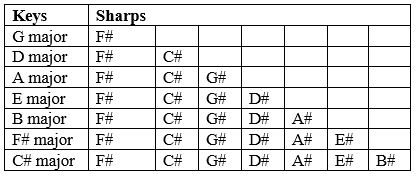Contemporary Music Theory
Pursuing Excellence
Personal Development
Leadership Principles
Administrative Skills
Major Scales With Sharps

In the last lesson, we learned how all major scales have the same pattern of intervals. It is tone, tone, semitone, tone, tone, tone, semitone.
Scales can contain either sharps or flats and for ease in memorising them, we'll deal with them separately.

Here is a table of major scales which have sharps in the key signature. As you will remember, there are no sharps or flats in the key of C and so it is not included in this table or the next. Notice there is a pattern. Look down the list and you will see that each successive major scale contains all the sharps which the scale above it contains, plus one extra sharp. This added sharp is always a semitone below the tonic note (the note from which the scale takes its name) of the scale and is called the leading note.
For example, in the key of A major, the last sharp added in the key signature will be a semitone below A, which makes it G#. To find all the sharps in that particular key, name the sharps in the list until you come to that sharp which was last added. To be able to do this, you will have to memorise the sequence F C G D A E B. If you can read music, you may already know that this is the order in which the sharps appear in the key signature. (If you can't read music, the key signature is where the sharps or flats are placed at the beginning of each line of written music to indicate what notes should be sharpened or flattened, and thus indicating the key of the music.)
This process can be reversed; given the number, or names, of the sharps in a particular key, you can work out the name of the key. Simply list in order the names of the sharps until you have counted the number of sharps given. The last sharp named is the leading note of the key. Raise it a semitone and you have the name of the key.
Example: Say you are told that the key you are playing in has four sharps, name the first four sharps in your sequence - F#C#G#D#. The last sharp added is the important one. Raise it one semitone and that gives you E, which is the name of the key. Therefore the major key with four sharps is E major. Note that if you apply this principle to a key with six or seven sharps, the sharps which you will have to raise a semitone will be E# and B# respectively. Since there is only a semitone between E and F, and also between B and C, this means that E# is actually F, and that B# is actually C. Raising these notes by a semitone gives you F# and C# respectively.
Notes which naturally occur in a key are referred to as diatonic notes.
Now read: Major Scales With Flats
Understanding Scales | Understanding Chord Structure | Understanding Diatonic Chords | Understanding Minor Scales | Diatonic Chords in Minor Keys | Scale Degree Names | Chord Substitution - Extended Chords | Chord Substitution - Overlapping Chords | Improvisation - Arpeggios | Improvisation - Major Scales | Improvisation - Pentatonic Scales | Improvisation - Blues Scales